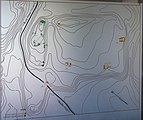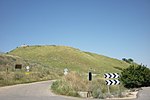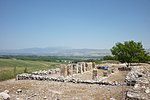Hazor
Hazor , also Hasor or Chazor ( Hebrew חָצֹר ḥāṣor , ancient Greek Ασωρ Asōr ), was a Bronze Age Canaanite metropolis on a tell in Upper Galilee north of the Sea of Galilee . Later it became an Israelite city and today it is a ruin, Tell Hazor or Tell al-Qeḍāh ( Arabic تل القضاه) or Tell Waqqas near Zefat . It was around 1800 BC. The largest city in Canaan . In 2005, the remains of Hazor were as part of the Biblical Tells - Megiddo, Hazor, Beer Sheba from UNESCO for World Heritage declared.
location
Tel Hazor is located in northern Israel, east of road 90 from Rosh Pina to Kirjat Shmona near Kibbutz Ayelet HaShahar. With almost 100 hectares, Tell Hazor is the largest of the biblical tells in Israel. The place was on strategic routes for trade and campaigns that connected Phenicia , Anatolia and Syria in the north with Mesopotamia and Egypt in the south. In addition to trade, agriculture in the fertile Chula plain was the basis for the prosperity of a city that was large at the time.
history
The first settlement of the part of the hill on which the upper town was located goes back to the beginning of the 3rd millennium BC. BC back. The lower town was built around 1800 BC. Built in BC. During the Bronze Age, Hazor comprised an area ten times the size of Jerusalem, which was then insignificant . The city should have had at least 20,000 inhabitants in its heyday. It traded and its rulers had extensive correspondence, as shown by clay tablets from Hazor and Mari . Egyptian texts of condemnation , Amarna letters (EA 148, 227, 228, 364) and war reports mention Hazor several times. In the Late Bronze Age, Hazor was the largest Canaanite city with an area of 74 hectares and was about eight times larger than Megiddo or Lachish .
- Hazor
Stone stairs to the cistern , modern spiral staircase on the right
Steles and offering tables from the Middle Canaanti period; Background: Chula Plain and Mount Hermon
In the 13th century BC Upper and lower town were destroyed. Who was responsible for this destruction is controversial. A connection between the destruction and the land grab is discussed, but also doubted. After that only the upper town on the hill was settled. Ben-Hadad of Damascus is said to have conquered Hazor and then rebuilt Omri on a smaller area. Around 733/732 BC Chr. Hazor of the Assyrians under Tiglat-Pileser III. finally destroyed.
Hazor in the Bible
Hazor is mentioned 20 times in the Bible , mostly in the Book of Joshua and the Book of Judges . According to the account in the Book of Joshua, King Jabin led a Canaanite coalition against Joshua into battle and was defeated. As a result, Joshua completely burned the city of Hazor. The judges' book reports of a conflict between King Jabin and the tribes under the leadership of the judge Debora . Hazor is also mentioned in the books of kings ( 1 Kings 9.15 EU and 2 Kings 15.29 EU ) and in the prophets Nehemiah ( Neh 11.33 EU ) and Jeremiah ( Jer 49.28 EU ).
Digs
The first test excavations were carried out in 1928 by the British archaeologist John Garstang . Targeted excavations were carried out in the years 1955–1958 and 1968/69 by Yigael Yadin in 14 sections (A – H, K – N, P and BA) in the upper and lower town excavations. Above all, he researched the structure of the city. The hill could be identified as a settlement relatively early, the function of the walled area - later identified as the lower town - was only clarified in the course of the excavations. Further excavations have been carried out under the supervision of Amnon Ben-Tor since the 1990s.
In the summer of 2012, a fragment of the Sphinx was unearthed, with an inscription dedicated to the Egyptian ruler Menkaura (2500 years BC). He comes from the Old Kingdom in Egypt. How the Sphinx came to Canaan has not yet been clarified. It is one of the few monumental Egyptian statues found in the eastern Mediterranean.
Find situation at the excavation site
Hazor consisted of the lower and the upper town. The ruins of the upper town are exposed and accessible to tourists. Parts of the city wall from the 10th century BC are from the upper town. Including the city gate with six chambers (' Solomonisches Stadttor'), three and two towers on each side and casemates visible to the south of it.
At the center of the upper town is the palace (reconstructed structures visibly separated from the original), the Canaanite kings in the 16th to 13th centuries BC. BC (late Canaanite period, Bronze Age) was used for ceremonial purposes. This meaning is u. a. through the discovery of a 'cult height' ('Bamah',בָּמָה, ( Ez 20.29 EU )). Steps lead to the palace entrance with two large reconstructed columns ( Syrian pilasters - these were common in Syria in the Bronze Age ), which stand on original pedestals. The lower parts of the mud brick walls are clad with basalt stones (originally preserved), the upper parts were made of cedar wood. To the east and south of the palace are older Canaanite structures, including a. Steles and sacrificial tables, from the middle Canaanite period (18th to 16th centuries BC).
The water system (cistern), the citadel with cult area on the western corner of the upper town as well as four-room houses and public warehouses ('column house') in the north of the upper town date from the time of the Israelite king Ahab , while the tower on the western corner was part of the late Israelite period of the defense system to ward off the Assyrian conquest (732 BC). On a lower level in front of the citadel is a cultic place ('Bamah') from the 11th century BC. BC (time of the judges ) recognizable. To the east of the 'columned house' and north of the 'Solomon City Gate' there is a transition between the upper and lower town from the late Canaanite period (16th to 13th centuries BC) with basalt slabs as part of or directly within the city wall Paved cult place including a 'Bamah' made of smoothed basalt stones and with drilled cavities of 2 cm in diameter, which could have served to fix a throne. Adjacent above are the remains of buildings from the time of Kings Solomon (10th century BC) to Ahab (9th century BC) with casemate walls 2.5 m apart and a series of rooms perpendicular to them currently (2018) are still being archaeologically examined.
literature
- General
- Wolfgang Zwickel : Hazor. In: Michaela Bauks, Klaus Koenen, Stefan Alkier (Eds.): The Scientific Biblical Lexicon on the Internet (WiBiLex), Stuttgart 2006 ff.
-
Yigael Yadin : Hazor I: An Account of the First Season of Excavations, 1955. Jerusalem 1958.
- Hazor II: An Account of the Second Season of Excavations, 1956. Jerusalem 1960.
- Hazor III / IV: An Account of the Third and Fourth Seasons of Excavations, 1957-1958. Jerusalem 1961.
- Amnon Ben-Tor u. a .: Hazor V: An Account of the Fifth Season of Excavations, 1968. Jerusalem 1997.
- Hazor VI: The 1990-2009 Excavations. The Iron Age. Jerusalem 2012.
- Israel Finkelstein : Hazor and the North in the Iron Age, a Low Chronology perspective. In: Bulletin of the American Schools of Oriental Research. 314, 1999, pp. 55-70, ISSN 0003-097X .
- S. Zuckerman: Anatomy of a destruction: crisis architecture, termination rituals and the fall of Canaanite Hazor. In: Journal of Mediterranean Archeology . 20, 1-31.
- Amnon Ben Gate, Ruhama Bonfil: Tel Hazor National Park (Flyer) . Israel Nature and Parks Authority, 2007 ( org.il ).
- To the chronology debate
- Israel Finkelstein, Neil Asher Silberman: No Trumpets Before Jericho, The Archaeological Truth About the Bible. Beck, Munich 2002, ISBN 3-406-49321-1 .
- Israel Finkelstein, N. Silberman: The Bible unearthed, archeology's new vision of Ancient Israel and the origins of its sacred texts. New York 2001, ISBN 0-684-86912-8 (English original title).
- Israel Finkelstein: State formation in Israel and Judah, a contrast in context, a contrast in trajectory. In: Near Eastern Archeology. 62, 1999/1, pp. 35-52.
- Texts
- Y. Goren: Provenance study of the cuneiform texts from Hazor. In: Israel Exploration Journal 50, 2000, pp. 29-42.
Web links
- The Hazor Excavations Project (English)
- Entry on the UNESCO World Heritage Center website ( English and French ).
- Immanuel Benzinger : Asor 1 . In: Paulys Realencyclopadie der classischen Antiquity Science (RE). Volume II, 2, Stuttgart 1896, Col. 1708 f.
- UNESCO: Biblical Tels (Israel), 443 kB
Individual evidence
- ↑ Hazor in: Microsoft Encarta online : "Hazor, Bronze Age Canaanite and later Israelite city, today the hill of ruins Tell al-Qedach or Tell Waqqas near Zefat in northeastern Israel."
- ↑ Yigael Yadin, Hazor I . Jerusalem 1958, pp. 1-2
- ^ A. Ben-Tor: Excavating Hazor, Part II: Did the Israelites Destroy the Canaanite City? In: BA 56/4, 1993, pp. 22-39 (quoted in: WG Dever: Who Were the Israelites? P. 67).
- ↑ Yigael Yadin et al. a., Hazor IV . Jerusalem 1958-1997
- ↑ Die Welt: How did the Sphinx from Mykerinus come to Northern Israel? , July 16, 2013.
- ↑ N24: Enigmatic Sphinx with hieroglyphics exposed , July 16, 2013.
Coordinates: 33 ° 1 ′ 5.6 ″ N , 35 ° 34 ′ 8.6 ″ E











